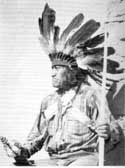Wilson Tawaquaptewa, Hopi Pueblo Katsina Carver
+ Add Artist to My Preferences

Wilson Tawaquaptewa is the earliest carver that we know by name and he created figures that were given to the children as well as pieces that he sold. His carving career spanned at least four decades.
Tawaquaptewa's Katsina dolls are unique. What distinguishes his dolls from all others of the same era (1920-1960) is that his carvings, ostensibly representing specific Katsinas, bear little resemblance to the actual Katsina figures that dance in the villages during the Hopi ceremonial cycle. Thus, one cannot make a positive identification as to what Tawaquaptewa's Katsinas dolls are intended to represent.
Tawaquaptewa would unhesitatingly alter the iconography of a Katsina doll in subtle ways. All his pieces were beautifully made, and his style is quite identifiable although it is sometimes difficult to determine which katsina he had in mind while carving. This was not by accident. As a religious leader at Hopi, he was not comfortable with selling authentic katsina dolls to tourists, so he made slight changes to the carvings. This satisfied his conflict with religion and sales and appeased the tourist who was unaware of the deception.
Wilson Tawaquaptewa was born of the Bear Clan in the Hopi village of Oraibi, Third Mesa, Arizona, in the year 1873. Oraibi was the largest and most important Hopi villages at the time of Tawaquaptewa's birth, and the Bear Clan was among the most significant clans at Hopi. Wilson Tawaquaptewa was Kikmongwi (Chief) of Oraibi Village at the time of the famous rift that occurred on September 8, 1906, which divided the village into progressives and traditionalists. The progressives were in favor of cooperating with the U.S. Government's policy that Hopi children must go to school. The traditionalists wanted nothing to do with the government's policies. After this time, Tawaquaptewa began to produce Katsina figures, rattles, tabletas, dance wands, and other traditional Hopi accouterments. He passed away in 1960.
Photo ca. 1944: Hopi Katsina: 1,600 Artist Biographies by Gregory and Angie Yan Schaaf.
** If you discover credit omissions or have additional information to add, please let us know at Marketing@adobegallery.com.

